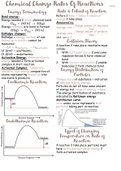Summary
Summary Grade 12 Rate of Reaction Notes (IEB syllabus)
- Course
- Institution
These notes offer a comprehensive guide to the theory needed to write final exams in matric. They contain all the information on Rate of Reactions in the IEB chemistry syllabus. They are typed in a column format for easy learning. They have an array of diagrams to aid learners in their physical sci...
[Show more]



